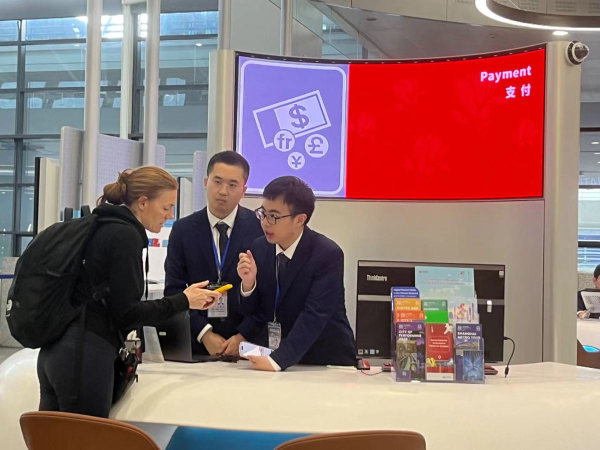China's seamless mobile payment enhances travel experience for foreign visitors

International travelers visit the new round-the-clock one-stop service station launched at Terminal 2 of Pudong International Airport on June 29, 2024. [Photo by Li Junfeng/chinadaily.com.cn]
DALIAN - When Jennifer Meriot, a graphic designer from France, returned to Dalian in Northeast China's Liaoning province after five years, she was pleasantly surprised by how seamless mobile payments had become for international travelers.
While buying snacks at night markets, Meriot could pay just like the locals by scanning a QR code. "In China, mobile payment is almost ubiquitous," she said. "With a phone, an international tourist like me no longer needs a wallet."
This shift greatly streamlined Meriot's shopping experience. She didn't have to exchange currency or withdraw cash from banks, saving a lot of time and hassle.
In Dalian, 14,300 businesses now accept payment through overseas bank cards, doubling the number from February this year and covering major areas such as airports, high-speed railway stations, passenger terminals, tourist attractions, international hotels, and core commercial districts, according to Zhang Shugang, deputy general manager of the Dalian branch of China UnionPay.
To cater to the growing international tourism influx, WeChat Pay, one of China's major mobile payment platforms by tech giant Tencent, now allows international users to link bank cards from six international bank card organizations, including Visa, to their WeChat account.
Dalian has also distributed bilingual WeChat Pay guides to nearly 10,000 taxis in the city. These guides, placed behind the front passenger seat, offer detailed instructions on downloading, registering, and linking a bank card to WeChat Pay, alongside a hotline for inquiries.
Many other cities across China have implemented similar innovative measures to ensure a smooth travel experience for international visitors. For instance, the "Shanghai Pass," a multi-purpose prepaid card for foreign visitors launched this May, can be used for payments at tourist spots, convenience stores in Shanghai, and for public transportation in over 330 Chinese cities.
According to a vendor surnamed Wu, these trends and measures have had a positive impact on her business.
Wu has been selling scallion pancakes near China's renowned West Lake scenic spot in East China's Zhejiang province for over 30 years. Despite not speaking any foreign languages, she has been able to serve international customers with ease by simply displaying a QR code at the storefront.
Wu noted that many foreign customers ask her in Chinese, "Can you scan my code, or I scan yours?" This simple digital tool and China's favorable measures for international visitors have bridged the language barrier.
"Enhancing payment convenience is crucial for optimizing the business environment and promoting high-quality opening up. Moving forward, it will be essential for the government, financial institutions, platforms and enterprises to work together in implementing and refining various measures to facilitate payments," said Li Yongjian, a researcher at the National Academy of Economic Strategy under the Chinese Academy of Social Sciences.
According to a circular issued last month by China's top economic planner -- the National Development and Reform Commission -- and four other government bodies, the country will promote acceptance of overseas bank cards in various venues and stores, enabling easier access to dining, accommodation, transportation, ticket purchases, and reservations for international visitors.

 China makes outstanding contributions to global energy transition
China makes outstanding contributions to global energy transition  Ningbo village inspires Malawi official
Ningbo village inspires Malawi official  A look at China's economic data in the first three quarters of 2024
A look at China's economic data in the first three quarters of 2024 


